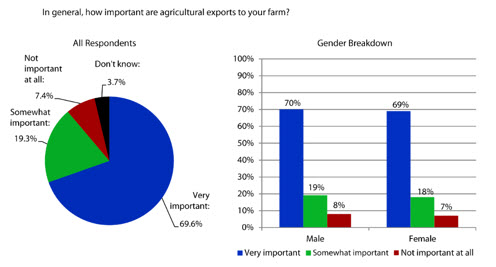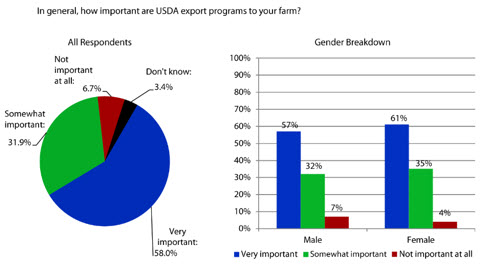WASHINGTON, Nov. 9, 2016 - Most American farmers understand the importance of agricultural exports to their farming operations because overseas sales of commodities, food products, animal skins and other products generate roughly 20 percent of U.S. farm income.
However, that same level of support does not seem to be transferring to what could be called the most important opportunity to expand exports in the foreseeable future: the Trans-Pacific Partnership (TPP). The pending trade agreement would boost demand for U.S. farm and food products among nearly 500 million consumers in 11 countries across the Asia-Pacific region and beyond. Those countries are Japan, Vietnam, Australia, New Zealand, Brunei, Malaysia, Singapore, Peru, Chile, Mexico and Canada.
The latest Agri-Pulse Farm and Ranch Opinion Poll found that almost 90 percent of our 750 respondents said that agricultural exports are either “somewhat” or “very” important to their farming operations. The survey was conducted Oct. 5-18 among commercial operations with at least 200 acres or more. Seventy-two percent of those responding farmed 1000 acres or less.
 A similar share indicated that they also view USDA export
programs as being important to their farm. USDA programs that can be used to
improve agricultural sales overseas include the Export Credit Guarantee Program
and the Market Access Program (MAP). See chart at right.
A similar share indicated that they also view USDA export
programs as being important to their farm. USDA programs that can be used to
improve agricultural sales overseas include the Export Credit Guarantee Program
and the Market Access Program (MAP). See chart at right.
However, when it comes to the TPP, only about a quarter of farmers seem to be familiar with this regional trade agreement. In fact, awareness has barely grown since January when we conducted a similar poll.
In January 2016, only 26 percent of the 750 farmers and ranchers surveyed in our nationwide poll were familiar with the TPP, and by October, that number had increased only one point - to 27 percent.
That’s despite the fact that over 200 farm and ranch organizations have expressed strong support for the TPP and one national organization – the National Farmers Union – has been voicing opposition.
 The relatively good news for TPP supporters is that – among
those who are familiar with the pending agreement and its potential to reduce
trade barriers – support has grown. Of those familiar with the trade agreement,
support for TPP increased from 33 percent in January to 46 percent in our
latest poll.
The relatively good news for TPP supporters is that – among
those who are familiar with the pending agreement and its potential to reduce
trade barriers – support has grown. Of those familiar with the trade agreement,
support for TPP increased from 33 percent in January to 46 percent in our
latest poll.
That should be somewhat reassuring to the folks at the U.S. Trade Representative’s office and USDA who have been crisscrossing the country, explaining how the TPP could lead to even higher farm incomes over time.
 But it also underscores the need for USTR and others to do a
better job explaining what TPP means to a wide variety of farmers and ranchers
who are either unaware or already opposed.
But it also underscores the need for USTR and others to do a
better job explaining what TPP means to a wide variety of farmers and ranchers
who are either unaware or already opposed.
Now that the election is over, supporters will need a lot more political support – from the farm and ranch community and other interest groups – if members of the U.S. Congress can ever be persuaded to bring the TPP up for a vote in such a toxic political environment for trade.
Former U.S. Trade Representative Clayton Yeutter tells Agri-Pulse that – given how long TPP has been discussed and debated – he is “astonished, and disappointed, at the incredibly low percentage of producers who are familiar with TPP.
Among other things, Yeutter says the low level of interest calls for “soul searching among our farm organizations as to what they must do to energize their members on an issue like this, which is mighty important to them, both as producers and as American citizens. If the U.S. fails to approve TPP, economic leadership in Asia passes to China by default. That will carry with it a heavy cost, to all Americans, but especially to segments of our economy, such as agriculture, that are heavily dependent on exports.”
#30
For more news, go to: www.Agri-Pulse.com

